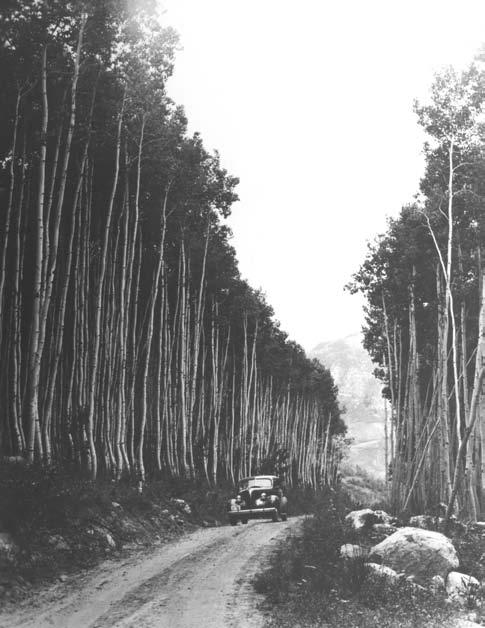
34 minute read
Whiskey or Water: A Brief History of the Cache National Forest
Whiskey or Water: A Brief History of the Cache National Forest
By MICHAEL W. JOHNSON
Shortly after the turn of the last century, Professor William Peterson of the Utah State Agricultural College embarked on a geological survey of the Bear River range. He planned to cover the mountain country from Blacksmith Fork Canyon to Soda Springs, Idaho, using a saddle horse and a pack horse. In earlier years, Peterson had become familiar with the area and felt secure that there would be adequate forage for his horses. He had not reckoned on the effects of a severe multi-year drought and a devastating increase in sheep grazing. Peterson recalled:

This Cache National Forest road passed through a grove of towering aspens near the Tony Grove Rangger Station
UTAH STATE HISTORICAL SOCIETY
The effects of this destruction were felt not only in the mountains but were visited on the valleys below. Mountain snow melt previously had been held back by groundcover, which had allowed it to sink into the soil and recharge the groundwater. Now it ran off quickly in the spring leaving irrigators without water in late summer. Increased soil erosion also caused problems. The Logan River ran muddy after storms, fouling Logan City’s drinking water and disgusting its citizens. The result was a crisis for both valley farmers and municipal water users. Angry Cache County residents attended a meeting in February 1902 to consider the issue. Many felt they should petition the federal government to protect the watershed by proclaiming it a forest reserve. On such reserves, lumbering and grazing were regulated and settlement was not allowed. Mayor Moroni Price of Smithfield commented, “I’ve been here ever since the mountains were little hills, and not until recent years have I suffered for lack of a decent drink of water, but after seeing the dead sheep and other animals that continually find a burial place in our streams, I have about reached a decision to drink whiskey from now on.” 2
Not all were in favor of the establishment of a forest reserve. Sheep man George Bell was opposed. A Mr. Hobbs of Benson thought that the brush on the mountains should be destroyed because it scratched his pants when he got out wood. Still, most people spoke in favor of federal protection. Jed Blair summed up the alternatives when he stated:
This crisis occurred less than fifty years after the settlement of the area by Mormon pioneers. Indeed, what Euro-Americans have called “the Winning of the West” came at a tremendous environmental cost. Native Americans affected the landscape, at times significantly, through hunting and burning, but white Americans came with the social organization and the tools to greatly reshape the countryside.
The pioneers that settled Cache Valley built their towns on alluvial fans at the mouths of canyons. This was where streams issuing from the mountains could be diverted to irrigate the bottomlands below. The canyons also furnished timber, which was needed in great quantities. There was a great appetite for fence posts and poles, logs and lumber for houses and farm buildings, and firewood. By the early 1870s, steam and water-powered sawmills were at work in the nearby hills making lumber for area communities. The coming of the railroads increased demand for local timber. Thousands of railroad ties were hand hewn in 1877 from trees in Blacksmith Fork, Cub River, and perhaps other canyons. These were floated down to the Bear River for delivery to the railroad at Corinne. With little regard for the value of the resource, settlers at times set forest fires as a form of amusement. 4
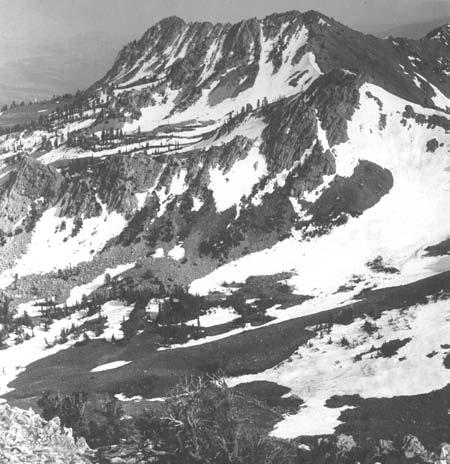
Ogden Canyon
Grazing animals were critical to the economy of these pioneers. Their livestock provided power for transportation and farm work, meat, dairy products, leather, wool, tallow, and a number of other products. At first, Mormon farmers kept their livestock on their town lots. Each day herd boys collected the animals, drove them to community pastures for grazing, and returned them to town in the evening. This arrangement offered security from rustlers and Indians. As these threats diminished, herd sizes grew, and Utah was drawn into the national economy, Mormon grazers began to adopt the practices of America’s open range livestock industry.
Like ranchers throughout the West, most Utah stockmen depended on free access to federal land. They might own their ranch headquarters, but their animals grazed largely on government lands that had not yet been purchased or homesteaded by private citizens. These were generally lands that were unsuitable for farming; arid lands without access to irrigation or mountain forests. Like many timber companies of the time, ranchers saw no reason to purchase and pay taxes on lands when they could use the resources on them for free.
Markets and declining range conditions pushed Western stockmen increasingly away from cattle and into sheep raising in the 1880s and 1890s. The geography of northern Utah proved ideal for sheep. Ranch headquarters were established on the irrigated farms of Cache Valley and along the Wasatch Front. These headquarters could grow feed and provide good areas for spring lambing. Sheep herds wintered on the West Desert, summered in the mountains, and paused at the ranch headquarters in the “oasis zone” as they passed from one to the other.
The problem was that there was much more winter range than summer range. As sheep numbers grew sharply, competition for summer range in the mountains became fierce. The emergence of “tramp” or “transient” herds exacerbated the situation. These were large herds that wandered far from their home ranch. They were grazed across the public lands with disregard for the customary rights of local ranchers, stripping the grass and moving on. Albert Potter, a government grazing inspector, estimated that in the summer of 1901, as many as 150,000 sheep were grazed in the Utah portion of the Bear River Mountains. 5
The problem was not just numbers. To grab a piece of the summer range, ranchers rushed their sheep into the mountains in May when the ground was still wet and before the ground cover was established. Thousands of hooves ground the canyon driveways down to mud and bare earth. Another problem was the practice of using the ridge lines as a driveway. Herds were driven along the crest from one canyon to another, often denuding the mountain tops of all vegetation. In summer, valley residents could see clouds of dust rising from the mountains as the huge sheep herds moved across the land. The severe drought of the late 1890s merely made the problems worse. 6
As these natural resource abuses developed across Utah and the West, a fledgling conservation movement developed in response. Progressives like Franklin Hough, dismayed at the destruction of resources that had once seemed inexhaustible, espoused the idea that government had a role in forest preservation.The federal government began to listen in the 1870s, making Hough a forestry agent in the Department of Agriculture. A few years later, Hough was placed in charge of the department’s new Division of Forestry, an agency that supported forestry largely on private lands. Bernhard Fernow, a forester trained in Germany, brought professionalism to the Division when he was named its chief in 1886.The movement’s influence grew, and in 1891 a short amendment was added to a bill in Congress that dealt with federal land laws. Sometimes referred to as the “Forest Reserve Act,” it authorized the President of the United States to occasionally, by proclamation, protect pieces of federal forest land by placing them in public reservations. 7
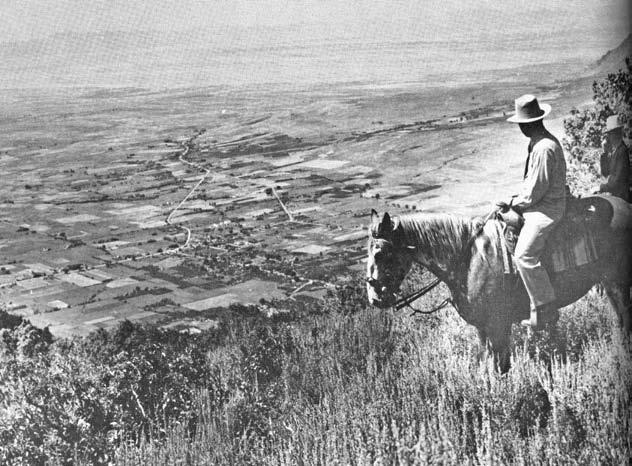
U.S. FOREST SERVICE
President Benjamin Harrison proclaimed the Yellowstone Park Timberland Reserve that same year. By the end of his administration in 1893, he had established fifteen forest reserves totaling some fifteen million acres. Following recommendations by the National Academy of Sciences, Congress created a National Forest Commission in 1896 that included Alexander Agassiz, Charles Sargent, and a young forester named Gifford Pinchot. The commission traveled throughout the country, surveying established and potential forest reserves. Based on its recommendations, President Grover Cleveland proclaimed thirteen new forest reserves on February 22, 1897, now known as the Washington’s Birthday Forests. The sudden creation of these reserves shocked many in Congress and prompted a new look at the establishment criteria and administration of the forest reserves. The eventual result was the “Pettigrew Amendment,” part of the 1897 Sundry Act. This provided that any new forest reserves must be created for the purpose of preserving forests, preserving watersheds, or for timber production. Whereas the original forest reserve act had made no provision for using the resources of the reserves, this act allowed for active management of resources on forest reserve lands. The Interior Department’s General Land Office, which oversaw the reserves, soon hired supervisors and rangers to manage and patrol them.
Gifford Pinchot, the first native-born American to be professionally trained as a forester, succeeded Bernard Fernow as the Chief of the Division of Forestry at the Department of Agriculture in 1898. Pinchot was a visionary who believed that the use of public and private forest resources must be put on a sustainable basis. His great frustration was that, although he was the nation’s forestry chief, the administration of the forest reserves remained within the Department of the Interior. This frustration would be ended by one of the turning points in American history.
The assassination of President William McKinley in September 1901 elevated Theodore Roosevelt to the White House. Roosevelt was an avid outdoorsman, a staunch conservationist, and a personal friend of Gifford Pinchot. His first State of the Union speech, presented in December 1901, praised the forest reserves and suggested additions to the system be made whenever practicable. He also called for control of the reserves to be transferred to Pinchot’s Bureau of Forestry at the Department of Agriculture. Though this change would not be officially made for a few more years, Roosevelt saw to it that Pinchot was in de facto control. 8 Roosevelt’s call for new forest reserves was heard not only in Washington but in Utah’s Cache Valley. Seeing a forest reserve as the solution to the valley’s watershed problems, Logan merchant Lyman Martineau, Professor George Swendsen of the agricultural college, civil engineer Edward Hansen, and others worked to get the attention of local officials. With the support of William Edwards, Chairman of the Cache County Commission, the idea was floated before the Commission on February 4, 1902.The Commission passed a resolution calling for a public meeting of county residents to consider the proposition. The Logan Journal praised the action stating, “The board of county commissioners demonstrated the fact that they are alive to the needs of their constituents...when they took action to secure governmental aid in protecting and maintaining the water supply of the county.” 9
Citizens from throughout Cache County gathered at the courthouse at 11:00 a.m. on February 15. After much discussion, a resolution was approved by an almost unanimous vote. It called on the President of the United States to set aside the watersheds of the Little Bear River, the Blacksmith Fork, Logan River, the Little Muddy, and the Cub River as a public reservation and exempt them from settlement. A committee consisting of Lyman Martineau, George Swendsen, Joseph Howell, Joseph Monson, F.K. Nebeker, Lorenzo Hansen, and J.C. Knowles were appointed to pursue the matter. 10
Federal officials responded quickly. The Deseret News of May 12, 1902, announced that the General Land Office was withdrawing the lands of the proposed forest reserve from settlement, entry, or sale. Albert F. Potter, a grazing inspector for the Department of Agriculture’s Bureau of Forestry, arrived in Logan to survey these lands on July 1. That day he met with Thomas Smart, a prominent sheep rancher who grazed his herd on the proposed reserve. Smart expressed his belief that the range was greatly overstocked with sheep, cattle, and horses, due in large part to transient herds from Idaho and other parts of Utah. Smart supported the creation of a forest reserve as a way of keeping transient herds off the local range. 11
Over the next several days, Potter met with local forest reserve supporters and rode throughout much of the country. Along the way he noted the various types of trees and vegetation, the effects of timber cutting, sawmills, ranches, and grazing conditions. His diary entry of July 8, 1902, was typical of his observations:

PAUL S. BIELER, PHOTOGRAPHER, UTAH STATE HISTORICAL SOCIETY
Potter’s observations confirmed that much of the proposed forest reserve had been overstocked with livestock and that most of the accessible timber had been cut. Though local reserve proponents favored a two-year moratorium on sheep grazing, he felt that grazing could continue as long as it was carefully monitored. Potter finished in the Logan area in late July, but he continued his survey down into central Utah looking for more additions to the forest reserve system. During 1902, Albert Potter was in the saddle for most of five months traveling Utah’s back country. 13
The following spring, President Theodore Roosevelt began a multiweek trip to several western states. He arrived by train in Salt Lake City the morning of May 29, 1903. Greeted by a large and enthusiastic crowd, Roosevelt rode in a parade to the City and County Building where he spoke to a gathering of school children. He then proceeded to the Salt Lake Tabernacle to make a formal address where he urged, “do not let the mountain forests be devastated by the men who overgraze them, destroy them for the sake of three years’ use and then go somewhere else, and leave so much diminished the heritage of those who remain permanently on the land.” On this day, Roosevelt signed the proclamation establishing the Logan Forest Reserve. At 107,540 acres, it contained most of the lands originally requested by Cache County’s citizens. Progressive government had created a mechanism for protecting critical forests and watersheds, and it had responded to the pleas of a community in crisis. 14
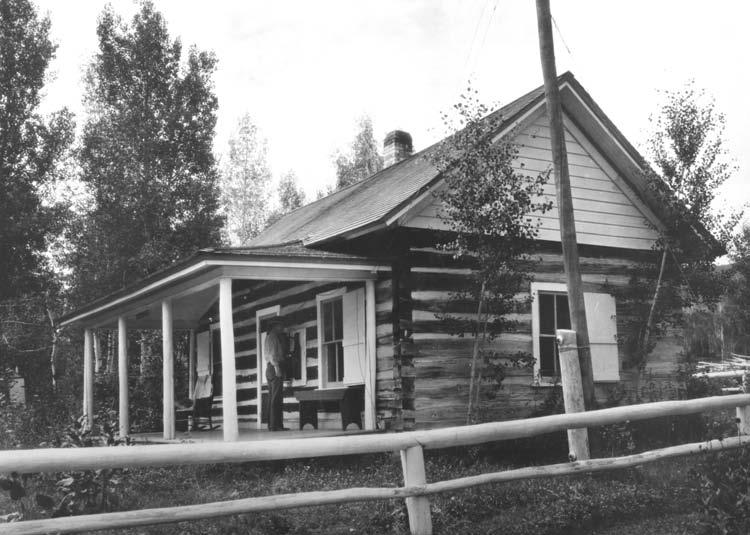
UTAH STATE HISTORICAL SOCIETY
John Fell Squires, a fifty-six year old Logan barber, was appointed Forest Supervisor. Joseph Howell of Wellsville, one of the original reserve proponents, had been elected to the U.S. House of Representatives in the fall of 1902, knew Squires as a man who loved to be out in the mountains and queried him about the possibility of accepting the job. A few months later, Squires’ appointment came down from the General Land Office. 15
Squires was born in Putway, England, in 1846, the second of John and Harriet Squires’ eight children. His family converted to Mormonism, immigrated to the United States, and crossed the plains to Utah in 1853. His father opened a barbershop in downtown Salt Lake City. As a young man, John F. fought in Utah’s Blackhawk War. He married in 1868 and moved to Logan in 1872 where he took up his father’s profession. Though a barber, Squires was no stranger to the outdoor life and he had a remarkable constitution. At the age of fifty-eight, he was still well able to do manual labor and spend day after day in the saddle. 16
James Leatham, a Wellsville farmer and school teacher, was appointed a ranger, and the first reserve office was established in Logan over the Co-op Drug Store. Squires worked the northern end of the reserve and Leatham looked after the Blacksmith Fork area to the south. As there were yet no guard stations, they spent many frosty nights under canvas in the spring and fall. Fighting the occasional fire and introducing a permit system for grazing occupied most of the men’s time. Where some one hundred fifty thousand sheep had grazed the area in 1901, seventeen permits for 33,950 sheep were issued in the new reserve. Seventy-one permits were issued for some five thousand head of cattle and horses. Squires took a lenient approach with the stockmen noting that, “We didn’t push them much though but tried to be easy on them and get them gradually to see what Uncle Sam wanted them to do.” 17
In Washington, D.C., Gifford Pinchot continued to push Congress to place the forest reserves officially under his control at the Bureau of Forestry. When the General Land Office became mired in scandal, Pinchot finally gained congressional approval for the change. Forest reserve administration was transferred to the Department of Agriculture’s Bureau of Forestry on February 1, 1905. At the beginning of the next fiscal year on July 1, Pinchot changed the name of the agency to the Forest Service.
Pinchot created a decentralized agency with a great deal of decision-making delegated to those in the field. To foster professionalism, he placed the agency under civil service rules, replacing the patronage system of employment that had been used by the General Land Office. New rangers were to be selected through a comprehensive written and field examination. Questions covered logging operations, scaling timber, the dimensions of a township, grazing practices, and how to build a log cabin. The field test included saddling and riding a horse, packing a horse with camp gear, and running lines with a compass. The Use Book, first published by the service in 1905, provided field personnel with a comprehensive guide to agency policies and could be carried in a pocket. 18
With President Roosevelt’s support, Pinchot’s staff actively searched out new forest lands for inclusion into the reserve system. On May 28, 1906, the Logan Forest Reserve was expanded to include most of the Bear River Mountains stretching to Soda Springs, Idaho, and it was renamed the Bear River Forest Reserve. Pinchot was uncomfortable with the term “forest reserve” because he thought it gave the impression that such lands were not to be used. To emphasize the idea that the government forests were to be utilized, he renamed all the reserves, including the Bear River, national forests the following year. The Bear River National Forest was more than John Squires felt comfortable supervising. He asked for a demotion in 1907 and was replaced by a Yale-trained forester named Willard Weld Clark. Clark felt his rangers needed professional training, so he organized a “short course” in forestry at the agricultural college that his staff could take during the winter. Just months after his arrival, Clark was severely injured when he fell on his saddle horn while riding. He was taken to the Card Canyon Guard Station where he died of pneumonia two days later. Mark G. Woodruff succeeded Clark, and Squires stayed on as deputy supervisor.
Meanwhile, an area in the Monte Cristo region, referred to as the “open township,” was suffering from the same overgrazing problems that had been seen in the Logan River watershed. Seeking relief from destructive over competition, local stock raisers appealed to the government to place the township into the national forest system. Monte Cristo Township was added to the Bear River National Forest in 1908, and the whole assemblage was renamed the Cache National Forest. The Cache grew again the following year when the Pocatello National Forest was merged into it. Mark Woodruff was transferred, and Clinton G. Smith, previously supervisor of the Pocatello National Forest, took control in Logan. 19
In addition to Smith as supervisor, the staff included John Squires as deputy supervisor, deputy forest ranger James Leatham, four assistant forest rangers, a forest guard, and Margaret Jensen as clerk. Ranger work was physically demanding involving manual labor and long days on horseback. Most of the Cache rangers had been cowboys and were in their twenties or thirties. An early Utah ranger recalled: “the distance around the country I had to oversee was about six hundred miles, all to be done with saddle horse and pack outfit....I rode hard every day and during the summer I used ten saddle horses, kept my horses and myself and received a salary of $60 per month.” 20
John Squires, at age sixty-three, kept up with the younger men. Supervisor Smith marveled at his physical condition, commenting that he, “Has been running boundary survey nearly all summer, and no one this age but a man of iron could have stood the rough life and tough work in running over 162 miles of Boundary.” 21
The work was also dangerous. The hazards of traveling rough country and doing construction projects were compounded by the often solitary nature of the job. Deputy ranger James Leatham had established a small station and tree nursery up the Left Hand Fork of Blacksmith Fork Canyon. A few days before Christmas 1911, Leatham, who was by himself, attempted to stop a runaway team of horses. Badly injured, he dragged himself to his cabin where he lay for two days without a fire. He then managed to crawl onto the back of his horse on Christmas Day and ride to the doctor in Hyrum. There he died a few hours later. Leatham Hollow, where his station stood, now bears his name. 22

A range management camp at the Tony Grove Ranger Station
By starting systems of regulated grazing and timber cutting, surveying forest boundaries, firefighting, building trails, and constructing guard stations and telephone lines, the early rangers laid the groundwork for their agency’s success. Forest service grazing practices were soon held up as a model for the rest of the nation’s public lands. In a 1925 article titled, “A Land Policy for the Public Domain,” agronomist George Stewart of the Utah Agricultural Experiment Station in Logan advocated a regulated system of grazing on federal lands not protected as national forests. Stewart, who was certainly familiar with conditions on the Cache, wrote: “The Forest Service ... has controlled grazing and stabilized the stock industry by building up the carrying capacity of big ranges, by preserving the integrity of the soil mantle, and by promoting good will among graziers, of whom none would now be willing to revert to the open range system.” 23
Stewart pointed out the continuing problems caused by overgrazing on public land, but privately owned rangelands were also being abused. This was made clear in 1923 when a summer cloudburst on the mountains east of Willard, Utah, spawned a massive mud flow that cascaded down Willard Canyon and poured right through the town. Water, muck, boulders, and debris cut a great swath of destruction across the rural community destroying orchards, fields, and farm buildings. Two women were crushed to death in their homes. In the aftermath, a study by Professor J.H. Paul of the University of Utah and F.S. Baker of the Forest Service’s Intermountain Region recommended that about one thousand acres of high mountain land above Willard be re-vegetated and protected from overgrazing and fires. The Civilian Conservation Corps did some terracing on Willard Peak in 1933, but the recommendations were largely ignored. 24
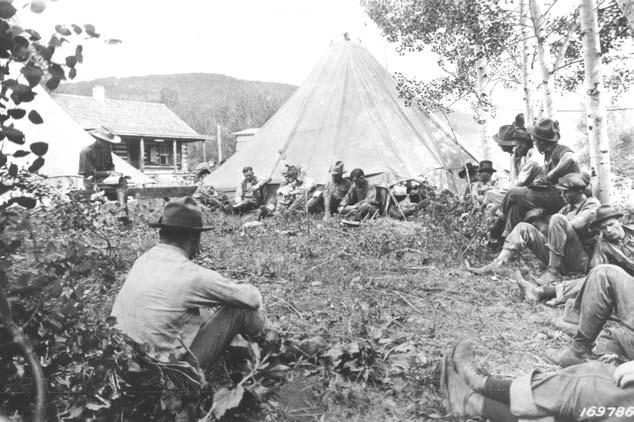
UTAH STATE HISTORICAL SOCIETY
On July 21, 1936, a summer storm created another disastrous debris flow that roared through Willard at 3:30 in the morning. Though no one was killed, property damage was listed at five hundred thousand dollars. This time action was taken. Willard City condemned private land on the mountain and invited the Forest Service to rehabilitate it. Under Forest Supervisor A.G. Nord, Cache National Forest and CCC personnel worked on an aggressive program of contour trenching along the mountain tops. Grazing and woodcutting were discontinued, and fire prevention was pursued. In 1941,Willard City donated the 1,807 acre tract around Willard Peak to the Cache National Forest. 25
Taking note of Willard’s action, local governments in Weber, Cache, and Box Elder County created partnerships with the Cache National Forest to stop erosion in their watersheds. The Weber County Watershed Protective Corporation purchased private lands around Wheeler Peak east of Ogden. These were given to the Cache forest for rehabilitation and protection. Local governments in Cache and Box Elder counties formed the Wellsville Mountain Corporation to purchase and protect critical watershed property in the Wellsville range. These partnerships, which remained active into the 1960s, brought another wave of expansion to the Cache National Forest. Once again, federal conservation had come to the aid of Utah communities in crisis.
Grazing and watershed protection were not the only activities of the Cache National Forest in its early decades. Lumber production took place on a small scale, but recreation blossomed. Utahns had long looked to the mountains and canyons as a place to relax and escape the summer heat. Adoption of the automobile and the construction of good roads vastly increased accessibility. To serve the public, but also to protect its land from being lost to the newly created National Park Service, the Forest Service started developing campgrounds, picnic grounds, and other recreational amenities.
A 1928 national forest press release titled “The Cache Playground” reported that 79,100 cars had traveled over the canyon road to Garden City the previous year, and 30,000 people had spent at least one whole day in Logan Canyon. Some 4,200 people lived in the canyon most of the summer in cabins built on lots leased from the Cache National Forest. More than 12,000 people used public campgrounds, and 14,500 boys and girls went to scout camps there. 26
During the 1930s, the Cache National Forest continued its program to lease summer home sites, and it continued to build recreational facilities. Summer homes were developed in Logan Canyon, Smithfield Canyon, High Creek, and the east fork of Mink Creek. The decade also brought an interest in the sport of skiing. When the Logan Canyon road was opened to year-round traffic in 1939, the Mt. Logan Ski Club sought development of a ski area. Under a special use permit agreement with the Forest Service, Logan City opened a rope tow at Beaver Mountain. It consisted of a half-inch steel cable powered by an unreliable old DeSoto car engine. A small rope tow was also installed that year near Ogden on Cache National Forest land in Wheeler Basin, known today as Snowbasin.
Ski development took off following World War II. Logan City’s Winter Sports Council decided to get out of the ski business, and Harold Seeholzer made a successful proposal to take over the Beaver Mountain ski area. Snowbasin put in its first chairlift the following year in 1946. By 1950, Seeholzer had added a new rope tow, a t-bar lift, and a warming shed. Even so, the sport had not yet become too fashionable. Luella Seeholzer sold lift tickets outside wearing an old army parka and air force flight boots. She put bottles of hot water in her pockets to keep her hands warm. 27
By 1953 the Cache National Forest could boast of seventy-eight developed campgrounds and picnic areas as well as two winter sports areas. These facilities were meant to make outdoor recreation available to all segments of society including the poor. A 1950s Forest Service vacation booklet touted the national forests’ recreational facilities, most of which were free to the public, stating “these opportunities are inexpensive, informal, and relatively undiscovered–open to enjoyment by everyone.” 28
The postwar era brought an expanding population, more development, and a growing environmental awareness in society. These changes brought new ideas and challenges to forest policy in the 1960s. Summer homes on the national forest, pushed strongly in the 1920s and 1930s, had come to be seen as intrusions by Cache National Forest managers. Removal of the cabins was viewed as the only solution, and leases were allowed to expire without renewal. Off-highway vehicles had also become a problem. Ranchers complained that operators of motorized bikes (tote goats) and four-wheel drive vehicles were harassing livestock, and forest service personnel noted that the machines were causing erosion on steep trails. Education was deemed the best approach to the situation as closures would be difficult to enforce. In addition, congressionally mandated user fees were initiated at campgrounds to help provide income for the federal government’s newly created Land and Water Conservation Fund. This fund was supposed to support the purchase of new recreational lands across the country. 29
The decade also saw the Forest Service at odds with the Utah Highway Commission over the rebuilding of Highway 89 in Logan Canyon. A 1962 Cache National Forest planning document noted that the project to widen the highway had, “become of more than local importance.” Conservationists opposing the project were locked in dispute with the Highway Commission and its boosters. The Cache National Forest opposed the highway plans and sought design changes, feeling that, “New highway construction in this limited area poses serious conflict with the stream, streamside vegetation, and recreational values.” 30
The Cache National Forest went through a major reorganization in 1973. Wanting to consolidate management units within state boundaries, the U.S. Forest Service administratively merged the Cache National Forest with the Wasatch National Forest, and its Idaho lands were placed under control of the Caribou National Forest. Logan remained the home of a ranger district, but the national forest headquarters were consolidated in Salt Lake City.
In the final decades of the twentieth century, national forest lands in northern Utah would be part of major and sometimes controversial shifts in public land management. The National Forest Management Act of 1976 created a complex process to plan the management of national forest units. The Endangered Species Act placed a new emphasis on the preservation of habitat for plants and wildlife, and the National Environmental Policy Act required environmental impact statements for many federal projects. Wilderness areas were created in the Wellsville Mountains and around Mt. Naomi as a result of the Forest Service’s second Roadless Area Review and Evaluation.
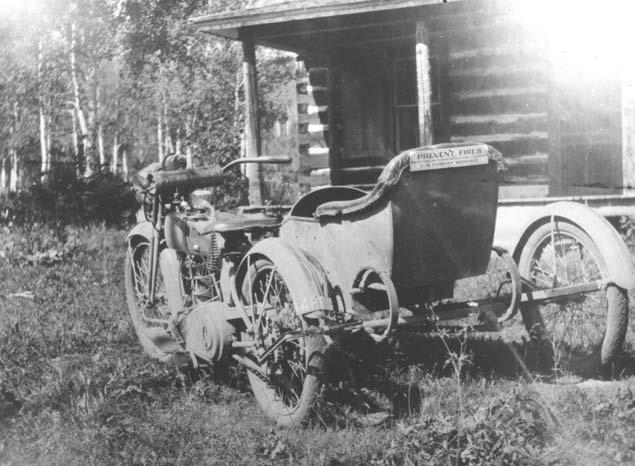
This vehicle parked in front of the Tony Grove Ranger Station in 1920 was dubbed “The Riveter ”
Users of campgrounds and picnic areas paid increasing fees to the Land and Water Conservation Fund, but only a fraction of these funds were used to purchase recreational lands as intended. Congress let the fund build up on paper as a way of masking part of the huge federal deficit. Because Congress seemed loath to use the Land and Water Conservation Fund, federal land managers turned more to exchanges as a way of obtaining critical lands. Unfortunately, the government often ended up on the losing end of such trades. A report of the General Accounting Office issued in 2000 stated that the government had lost millions of dollars on land exchanges, often purchasing land for more than its worth and disposing of land for less than market value. It recommended that Congress stop the Bureau of Land Management and the U.S. Forest Service from making future land exchange deals because the trades often did not serve the public interest.
Two such exchanges were visited upon the lands of the old Cache National Forest in the late 1990s. Industrialist Earl Holding had purchased Snowbasin ski area in 1984 and soon made clear his intentions to expand the facility into a four-season destination resort. To do this, Holding began negotiations with the Wasatch-Cache National Forest in 1989 to acquire hundreds of acres. Forest Service officials originally agreed to a small exchange of 220 acres, but under political pressure from Utah Senator Orrin Hatch the exchange was expanded to seven hundred acres.
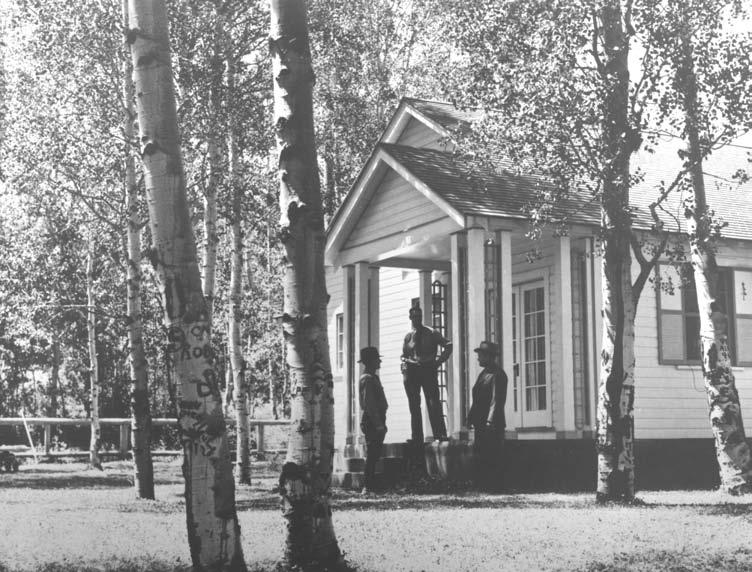
PAUL S. BIELER, PHOTOGRAPHER UTAH STATE HISTORICAL SOCIETY
Not satisfied, Holding saw an opportunity to enlarge the land deal when the 2002 Winter Olympics were awarded to Salt Lake City. Claiming that forest service lands were needed by Snowbasin to construct Olympic ski venues and amenities, Holding worked with Congressman James Hansen and Senator Hatch to introduce legislation in 1995 authorizing a trade for some one thousand three hundred acres. Though fewer than one hundred acres were actually needed to construct the Olympic facilities, Congress passed the legislation for the two square mile exchange and exempted the project from the normal NEPA review process. Snowbasin projected in its master plan that this land would eventually be developed with 199 large single-family homes, 467 townhouses, 818 condominiums, 1,092 hotel rooms, and a golf. course. These beautiful meadows and wetlands had offered the public outstanding cross-country skiing, hiking, and recreation opportunities. The Wasatch-Cache eventually received 11,777 acres of grazing land in widely scattered parcels to complete the trade. 31
Three years later, a land exchange of even greater proportions was executed between the federal government and the State of Utah. Attempting to mend fences with Utah officials after the controversial creation of the Grand Staircase-Escalante National Monument, the Clinton administration worked out a trade for state-owned School and Institutional Trust Lands Administration sections that were held in national parks, national forests, and other federal reservations. As part of the deal, Utah received what it classified as three thousand acres of commercial property in and around Beaver Mountain Ski Resort. Like Earl Holding, the State of Utah figured that these lands acquired from the Wasatch-Cache National Forest had outstanding potential for development. 32
Certainly much had changed over the course of a century. In the early 1900s, citizens of northern Utah saw their water supplies shrink and become polluted due to overgrazing in the nearby mountains. They turned to the federal government to regulate resource use, protect the water supply, preserve natural beauty, and insure public access. The Cache National Forest accomplished its job so well that years later, Utah communities purchased thousands of acres of abused private lands and gave them to the agency to be rehabilitated and protected. Eventually, dust clouds were no longer kicked up by sheep herds on the mountain tops, the Logan River ran clear once again, and regular debris flows after summer storms became a thing of the past. As the century closed, success had made the national forest into prime recreational land on the doorstep of one of the West’s largest urban areas.
In its next century, the Wasatch-Cache National Forest will have to deal with its success. It must balance the needs of its growing user groups, improve logging and grazing practices, protect wilderness and endangered species, and promote forest health. Managers will have to balance access with the need to collect user fees and resist attempts by developers to raid the public lands using the land exchange process. It is a far cry from the days when rangers were largely concerned with sheep grazing and firefighting, yet the challenge ultimately remains the same—to protect lands and watersheds while maintaining access and sustainable use.
NOTES
Michael W. Johnson is the Director of the Utah History Fair, Utah State University.
1 William Peterson,“Conservation of the Public Domain,”Utah Cooprative Extension Service New Circular Series No.39 (Logan:Utah Cooperative Extension Service,n.d.),quoted in F.Ross Peterson, A History of Cache County (Salt Lake City:Utah State Historical Society and Cache County Commission, 1997),167.
2 The Logan Journal, February 18, 1902.
3 Ibid.
4 Memorandum for Forest Supervisor:Additional data submitted by Elmer F.Merrill,”Cache National Forest Records,microfilm,Utah Reel 349 no.4,Special Collections,Utah State University; Cache National Forest Map,1962,Special Collections,Utah State University.
5 Albert F.Potter,“Diary of Albert F.Potter,July 1,1902 to November 22,1902,”unpublished typescript,Special Collections,Utah State University.Albert Potter was an Arizona stock raiser who was hired by Gifford Pinchot to be a government grazing inspector.Potter rose quickly in the agency and became the Forest Service’s first Chief of Grazing.
6 Albert F.Potter,“Forest Conditions in Utah:Prepared for the Society of American Foresters,”1903, Records of the U.S.Forest Service,RG 95,National Archives and Records Administration,College Park, Maryland;Cache National Forest Map,1962,Special Collections,Utah State University.
7 Franklin Hough was a New York physician who became interested in forestry.Hough urged Congress to become involved in forestry issues at an 1873 meeting of the American Association for the Advancement of Science.He became the first Chief of the Agriculture Department’s Division of Forestry and is sometimes referred to as the Father of American Forestry.Bernhard Fernow,a German immigrant, was trained in Germany as a professional forester and was appointed by President Grover Cleveland to head the Division of Forestry in 1886.Fernow assembled a professional staff,was an activist,and believed the government should hold on to and manage its forest lands.
8 Theodore Roosevelt,“”First Annual Message,”December 3,1901, The Works of Theodore Roosevelt, Volume 15,State Papers as Governor and President (New York:Charles Scribner’s Sons,1926,102-04.)
9 The Logan Journal, February 6,1902.
10 Ibid.,February 18,1902.
11 Potter,“Diary of Albert F.Potter.”
12 Ibid.
13 Ibid.
14 Salt Lake Tribune, May 30,1903; The Logan Republican, June 5,20, 1903.
15 "First Cache Forest Head Recalls Work," The Logan Herald Journal, September 30, 1932.
16 Ibid.
17 Ibid.“History of Cache Forest is Told,”n.d.,news clipping in history files Logan Ranger District, Wasatch-Cache National Forest;Potter,“Diary of Albert F.Potter;”U.S.Department of the Interior, Annual Reports of the Department of the Interior for the Fiscal Year Ended,June 30,1904, “Report of the Commissioner of the General Land Office,”630,631.
18 “Departmental Service–Forest Ranger Examination,”U.S.Forest Service Collection,Duke University Library,www.lib.duke.edu/forest/usfscoll/people/Ranger_Life/ranger08.html Accessed October 8,2003.
19 “ Monte Cristo History,”Cache National Forest Records,microfilm,Utah Reel 349 no.4,Special Collections,Utah State University.
20 William Anderson,n.d.,8,unpublished typescript in the history files of the Ashley National Forest, Vernal.
21 Report of Clinton G.Smith in the history files of the Logan Ranger District,Wasatch-Cache National Forest,Logan.
22 “History of Cache Forest is Told,”Logan Ranger District,Logan.
23 George Stewart,“A Land Policy for the Public Domain,” Economic Geography 1 (March 1925):90.
Charles Peterson and Linda Speth, A History of the Wasatch-Cache National Forest (Logan:Utah State University,1980),229-30.
25 Ibid.
26 “The Cache Playground,”(n.a.,n.d.).,“Cache National Forest Records,”microfilm,Utah Reel 349 no.4,Special Collections,Utah State University.
27 “Seeholzers Build a Ski Playland,” The Logan Herald Journal,February 27,1970;“Snowbasin History,” www.snowbasin.com/about/history.htm Accessed October 18,2003.
28 U.S.Forest Service,“National Forest Vacations,”U.S.Forest Service Collection,Duke University Library,www.lib.duke.edu/forest/usfscoll/Recreation/NF_Vacations.html.(October 18,2003);“Cache National Forest Map,1953,”Special Collections,Utah State University.
29 R.E.Crowell,“Cache National Forest Information and Education Analysis and Plan:Fiscal Years 1962-1966,”Cache National Forest Records,microfilm,Utah Reel 349 no.4,Special Collections,Utah State University.
30 Crowell,“Cache National Forest Plan:1962-1966.”
31 The Seattle Times, October 1, 1998.
32 "Utah Schools and Federal Land Exchange, May 8, 1998," www.utahtrustlands.com/pdfs/brief.pdf






